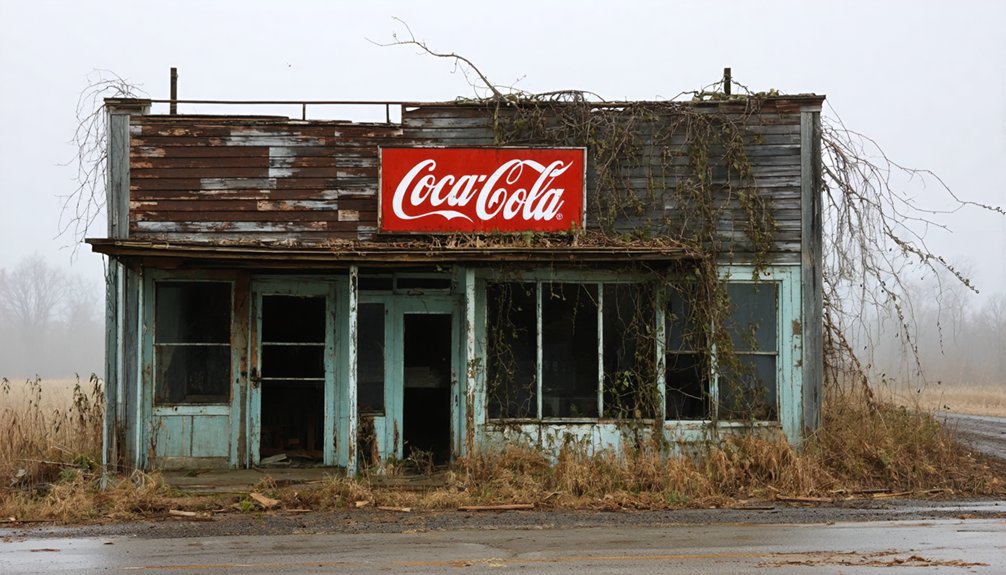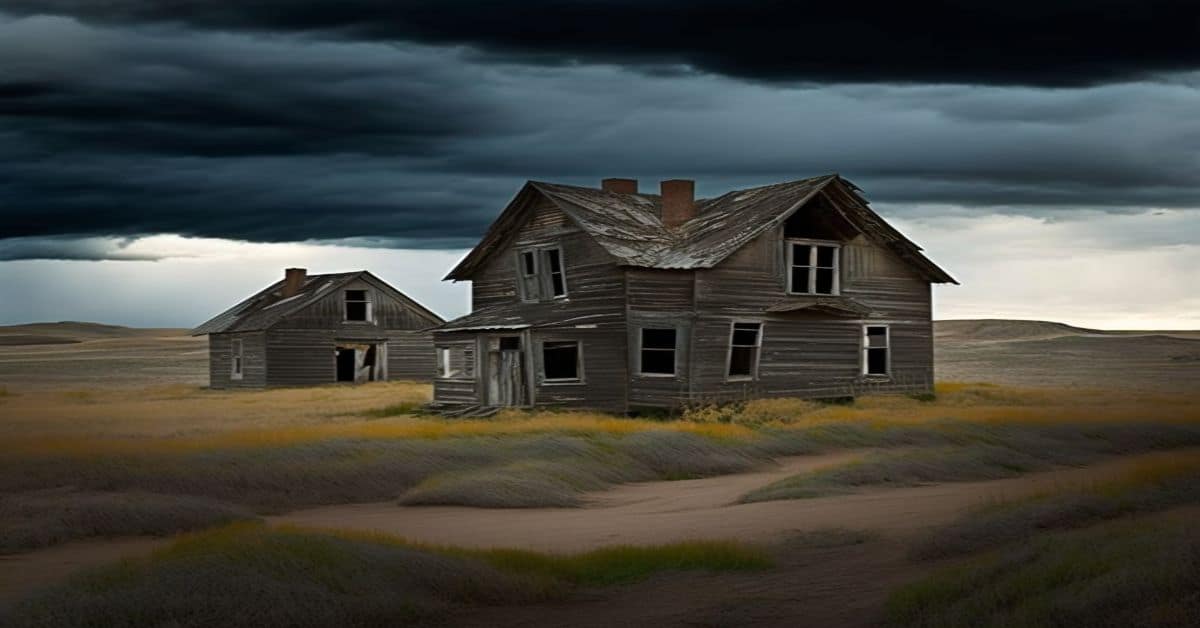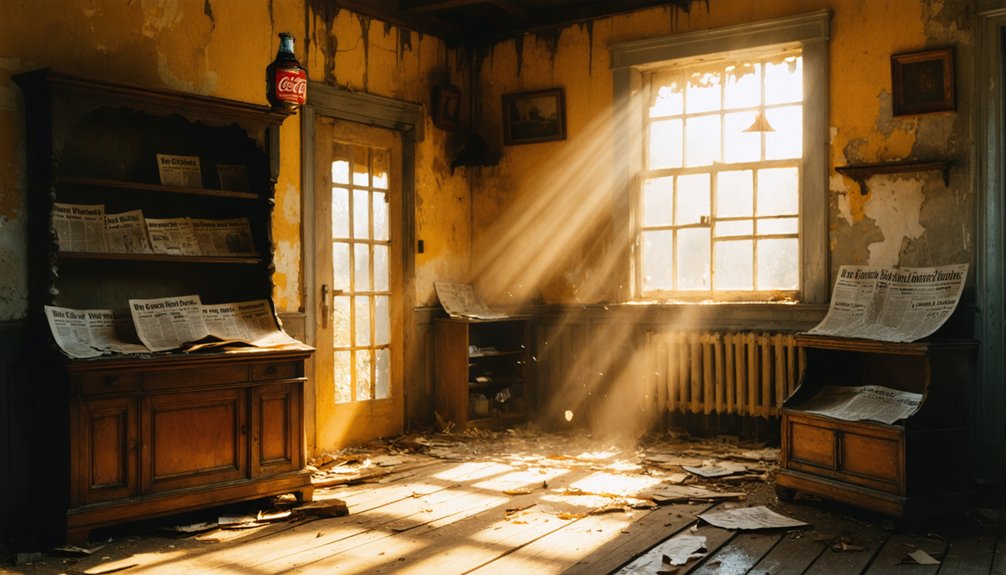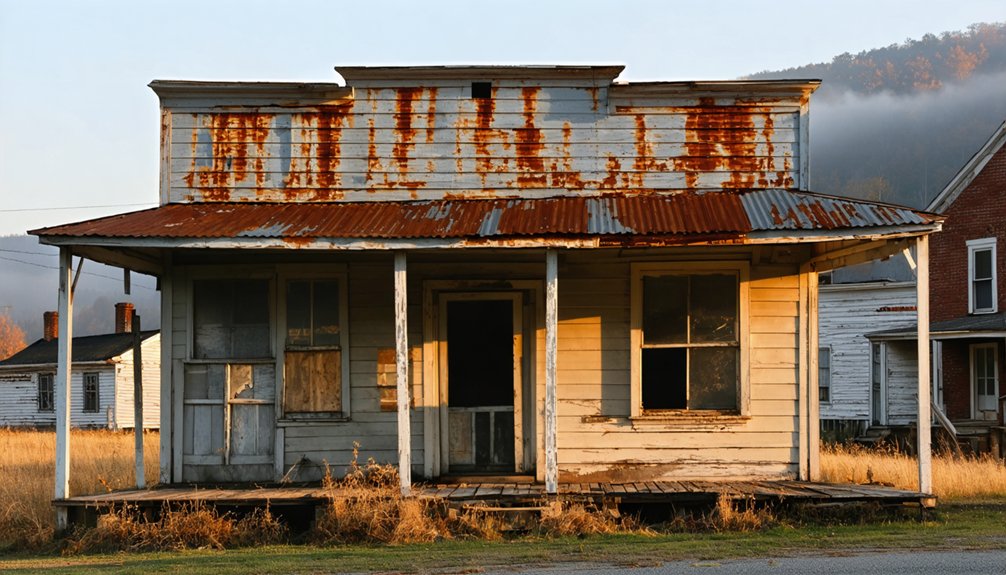You’ll find the abandoned town of Fudge just four miles southwest of Hickman, Kentucky, where limestone-rich terrain and agricultural challenges doomed this 1850s frontier settlement. The small community of less than 50 residents struggled with unstable ground, flooding, and poor farming conditions before its eventual abandonment. Today, several deteriorating farmhouses and barns remain hidden among dense forests, while the site’s haunting atmosphere has attracted music video productions like The Flaming Lips. The story of Fudge reveals fascinating insights into Kentucky’s challenging frontier life.
Key Takeaways
- Fudge was established in the 1850s as a small farming community located four miles southwest of Hickman, Kentucky.
- The town failed primarily due to limestone-rich terrain, unstable ground conditions, and severe agricultural challenges.
- Less than 50 residents occupied Fudge before its abandonment, with most families struggling to maintain viable farms.
- Several abandoned farmhouses and barns remain, though they’re deteriorating and surrounded by dangerous sinkholes and unstable ground.
- The ghost town now serves as a filming location for music videos, including works by The Flaming Lips and Big Red Bouncer.
The Rise and Fall of a Forgotten Settlement
While many ghost towns in Kentucky boomed before their decline, Fudge’s story stands apart as a settlement that never truly flourished. You’ll find its origins in the 1850s, just four miles southwest of Hickman, where hopeful settlers established a tiny community of less than 50 residents.
The settlement challenges these pioneers faced proved insurmountable. Despite their determination, the limestone-rich terrain created unstable ground conditions, while agricultural limitations sealed their fate. These abandoned structures have since become popular backdrops for music video productions. Due to lack of proper documentation, many details about the town’s history remain unreliably sourced.
Despite settlers’ resolve, Fudge’s limestone foundation and poor farming conditions doomed the community from the start.
You couldn’t grow much in the poorly draining, highly saline soil, and without viable farming, the community couldn’t sustain itself. By the late 19th century, families had abandoned their dreams, leaving behind only scattered structures as evidence of their brief struggle.
Today, these surviving buildings quietly remind us of Fudge’s short-lived existence.
Natural Challenges That Doomed the Town
Although the settlers of Fudge had high hopes for their new community, the natural environment quickly crushed their dreams.
You’ll find that the town’s downfall stemmed from multiple geological challenges – the limestone bedrock created unstable ground conditions while poor drainage led to constant flooding.
Soil erosion and high salinity made farming nearly impossible.
The land’s natural limitations sparked a chain of agricultural failures, forcing residents to rely on expensive imported goods.
Like the abandoned settlement of Elsewhere, Kentucky, Fudge became a ghost town with only remnants of buildings remaining.
You couldn’t grow enough food to sustain even a small population, and the standing water created serious health hazards.
With sinkholes threatening buildings and waterlogged fields yielding no crops, you can understand why settlers abandoned Fudge within just a few years.
The harsh reality of nature had spoken – this land simply wasn’t meant for human settlement.
Like many resource-depleted communities across Kentucky, Fudge’s inhabitants were forced to relocate in search of more viable land.
Life in Early Fudge: A Brief Existence
The story of daily life in Fudge reveals a community that fought against nature’s odds until its final days. You’d find fewer than 50 residents, mostly farming families, working together to survive in this remote outpost near the Mississippi River.
Their daily routines centered on tending crops and livestock, though the challenging soil made this an uphill battle. Despite having no formal institutions, community bonds remained strong as neighbors relied on each other and nearby Hickman for essential services. Like many other ghost towns in Kentucky, Fudge represents a piece of frontier history that has faded into memory. Due to severe economic decline, the residents gradually left their homes behind.
You can imagine the determination of these pioneers as they built simple farmhouses, shared resources, and supplemented their diets through hunting and fishing. While they didn’t leave many records behind, their brief struggle to establish a foothold in Kentucky’s frontier demonstrates the resilient spirit of early American settlers.
What Remains Today: Exploring the Ruins
As you explore Fudge’s ghost town site today, you’ll find several abandoned farmhouses and barns slowly disappearing into the thick Kentucky vegetation.
Like the abandoned high school buildings in Lynch, Kentucky, the deteriorating structures show the impact of years of neglect.
The area was once a bustling center for timber and coal production, similar to what made Elkatawa thrive in the late 1800s.
You’ll need to watch your step carefully, as the limestone-rich soil harbors dissolving caverns that create dangerous ground instability beneath the ruins.
While these crumbling structures now serve as haunting backdrops for music videos, they’re steadily succumbing to the elements without any preservation efforts in place.
Crumbling Structures Still Stand
Several abandoned farmhouses and outbuildings still dot the landscape of Fudge, Kentucky, offering a haunting glimpse into this once-thriving rural community.
You’ll find weathered wooden structures showcasing the region’s traditional abandoned architecture, from deteriorating barns to crumbling residential homes that stand as silent witnesses to the past. The area’s decline mirrors many communities that flourished during the tobacco farming era before economic shifts forced residents to leave.
The rural decay is particularly striking, with collapsed roofs, broken windows, and foundations slowly giving way to nature’s reclamation.
Underneath these structures, limestone caverns create unstable ground conditions, contributing to the buildings’ ongoing deterioration through sinkholes and subsidence.
Despite their precarious state, these ruins have become a magnet for photographers and artists who capture the compelling interplay between man-made structures and the encroaching wilderness, though you’ll need to navigate carefully on unpaved roads to reach them.
Hidden Among The Vegetation
Deep within Fudge’s forgotten landscape, dense forests and thick underbrush have steadily reclaimed the town’s remnants, making ruins challenging to spot without careful exploration.
The vegetation camouflage transforms with each season, concealing old farmhouse foundations, collapsed walls, and rusting equipment beneath its ever-growing canopy.
If you’re planning to venture through these historic grounds, you’ll face several exploration challenges:
- Unpaved access roads blocked by fallen trees and overgrowth require strategic navigation
- Hidden sinkholes and unstable terrain demand careful footing
- Dense undergrowth obscures structural remains, necessitating thorough visual scanning
The limestone-rich soil that once deterred farming now supports thriving native plants, creating a natural sanctuary where wildlife flourishes among the ruins.
You’ll find the ghost town’s secrets revealed only through patient, mindful investigation of this naturally reclaimed landscape.
Dangerous Ground Below Ruins
While the lush vegetation above ground creates its own set of challenges, the real danger in Fudge lies beneath your feet.
You’ll need to watch your step carefully as you explore the ruins, as the limestone caverns underneath have created serious ground instability throughout the area. The once thriving area was devastated by Peabody Coal Company. These geological features have led to numerous safety concerns, with the risk of sudden collapses being a constant threat.
If you’re planning to visit the abandoned structures that still dot the landscape, you’ll want to exercise extreme caution.
The poor drainage and high soil salinity haven’t just made farming impossible – they’ve also weakened the foundations of the remaining buildings. The unstable ground conditions continue to threaten what’s left of this historic Kentucky ghost town.
Historical Significance in Kentucky’s Rural Past
Throughout Kentucky’s early settlement history, Fudge stands as a compelling demonstration to the harsh realities faced by rural communities in the mid-19th century. The town’s short-lived existence and settlement patterns reflect the unforgiving nature of frontier life, where survival depended on the land’s ability to sustain agriculture.
The cultural significance of Fudge extends beyond its physical remains:
- Its abandonment serves as a stark reminder of how environmental conditions could make or break early settlements.
- The town’s story preserves valuable insights into the challenges that shaped Kentucky’s rural development.
- The remaining structures stand as silent witnesses to the determination of frontier families seeking independence.
You’ll find that Fudge’s legacy continues to resonate with modern discussions about sustainable community development and rural resilience.
Modern Cultural Impact and Legacy
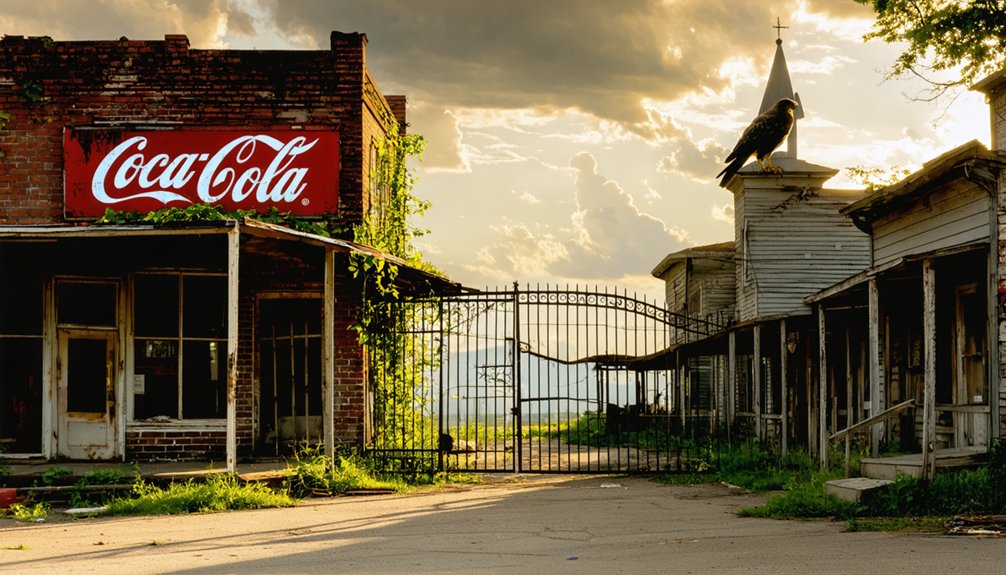
You’ll find Fudge’s most prominent modern cultural footprint in the music videos shot against its hauntingly beautiful backdrop, including works by The Flaming Lips and Big Red Bouncer.
The town’s abandoned structures and scenic surroundings continue to draw photographers and filmmakers who seek to capture authentic pieces of rural American history.
Local preservation efforts remain essential to maintaining these valuable filming locations, though funding and environmental challenges create ongoing concerns for the community.
Music Video Filming Location
Since its abandonment, Fudge, Kentucky has found new life as a mesmerizing backdrop for music video productions, particularly within the alternative and rock genres.
You’ll discover a hauntingly beautiful setting where bands like The Flaming Lips and Big Red Bouncer have captured their artistic visions through distinctive music video aesthetics and creative filming techniques.
The ghost town’s appeal for videographers stems from several key features:
- Well-preserved abandoned farmhouses that create an authentic desolate atmosphere
- Remote location that guarantees uninterrupted filming opportunities
- Natural limestone features that add unique atmospheric effects
You’re witnessing Fudge’s transformation from forgotten town to cultural canvas, as its crumbling structures continue attracting artists seeking raw, unfiltered backdrops for their visual storytelling.
The site’s popularity among musicians has helped preserve its legacy through digital media.
Local Historical Preservation Status
Despite its cultural significance as a filming location, Fudge lacks formal historic preservation status or recognition on the National Register of Historic Places.
You’ll find no active preservation projects or public records targeting the restoration of its remaining structures. The town faces significant preservation challenges, including deteriorating buildings, natural reclamation, and geological issues stemming from poor soil conditions and limestone caverns.
While Preservation Kentucky promotes historic sites throughout the state, they haven’t specifically included Fudge in their advocacy efforts.
Community engagement remains minimal, with local historical societies focusing their attention on larger, more prominent towns in the region.
The site’s rural location, about 4 miles southwest of Hickman, and lack of visitor infrastructure further complicate efforts to maintain its historical legacy.
Frequently Asked Questions
Are There Any Documented Deaths or Burials in Fudge’s History?
Despite your Google-like search through historical records, you won’t find any documented deaths or ghostly encounters in Fudge – there’s no evidence of burials or fatalities during its brief 1850s-1860s existence.
What Happened to the Original Land Deeds of Fudge’s Settlers?
You won’t find complete historical records of the original land deeds, as they’ve been lost over time. Local archives in Fulton County might hold fragments of land ownership documentation.
Did Native American Tribes Inhabit the Area Before Fudge’s Establishment?
While specific records are scarce, you’ll find that Native tribes like the Shawnee and Cherokee inhabited Kentucky’s regions, with historical artifacts showing indigenous presence dating back thousands of years before Fudge’s establishment.
How Did the Town Get Its Unusual Name?
You won’t find any documented explanation for Fudge’s origins or name significance. While the town existed in the 1850s-1860s, historical records don’t reveal why early settlers chose this unique name.
Are There Legal Restrictions for Visiting the Remaining Structures Today?
You’ll need landowner permission to visit, as visitation regulations protect private property rights. Many structures are unsafe, and preservation efforts require respecting both legal restrictions and community guidelines.
References
- http://unusualkentucky.blogspot.com/2009/05/fudge-ky.html
- https://kids.kiddle.co/List_of_ghost_towns_in_Kentucky
- https://womiowensboro.com/have-you-ever-visited-these-ghost-towns-in-kentucky-video/
- https://wbkr.com/visit-these-20-creepy-kentucky-ghost-towns-for-a-halloween-road-trip/
- https://en.wikipedia.org/wiki/List_of_ghost_towns_in_Kentucky
- https://thoughtcatalog.com/seamus-coffey/2015/08/theres-a-town-in-kentucky-that-you-wont-ever-be-able-to-find-on-a-map-and-for-good-reason/
- https://www.bsu.edu/-/media/www/departmentalcontent/aal/aalpdfs/roi-51-75/roi-67-public.pdf
- http://solomonjparker.blogspot.com/2011/06/ghost-towns-in-kentucky-vol-1.html
- https://kentuckykindredgenealogy.com/2017/03/31/kentucky-fudge-company-harrodsburgs-historic-and-culinary-treasure/
- https://www.youtube.com/watch?v=D9gOmfCuKLs
